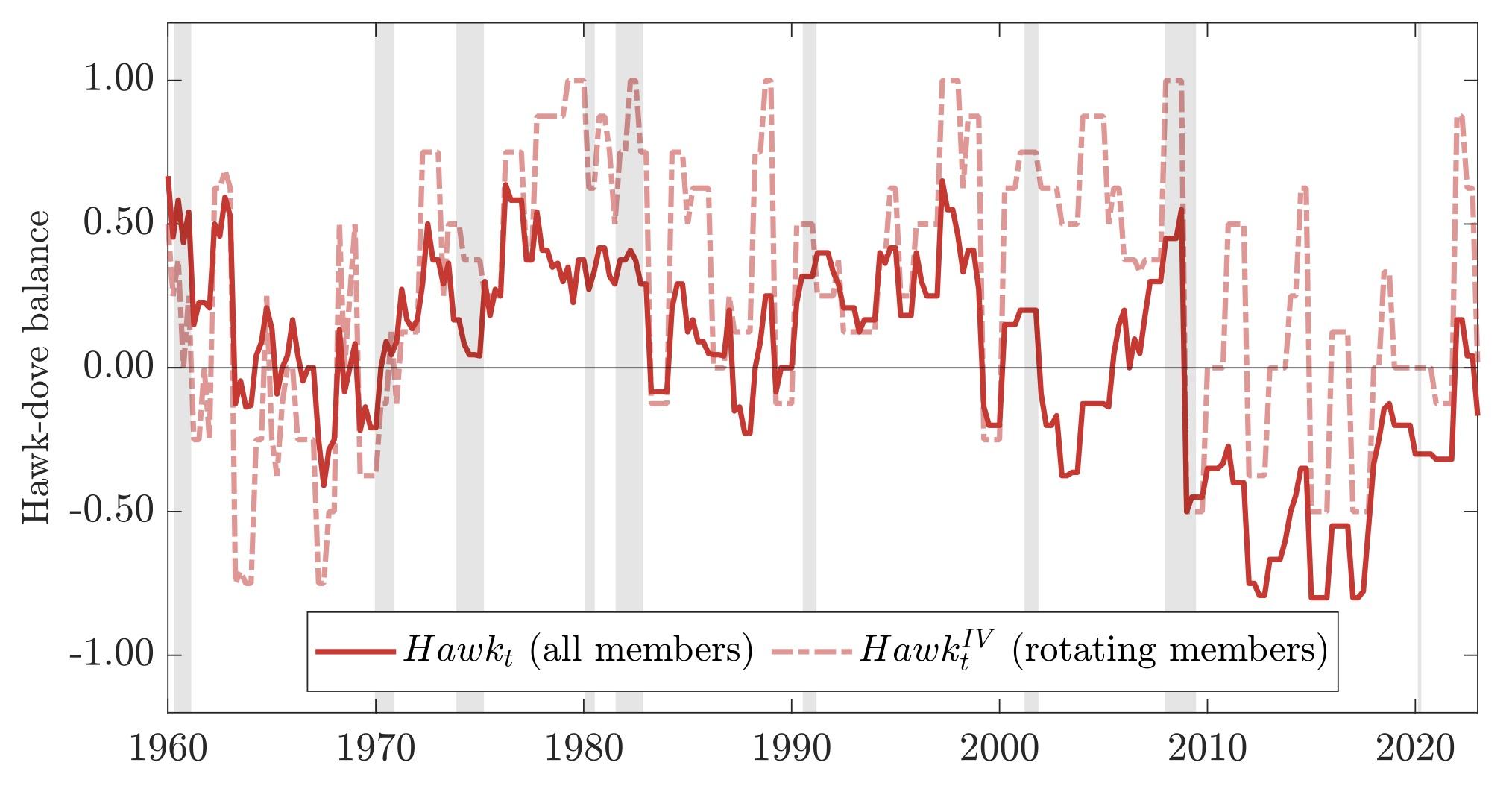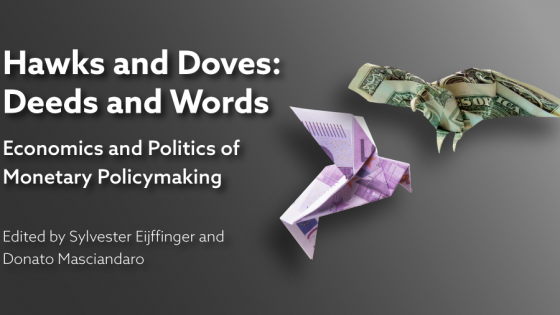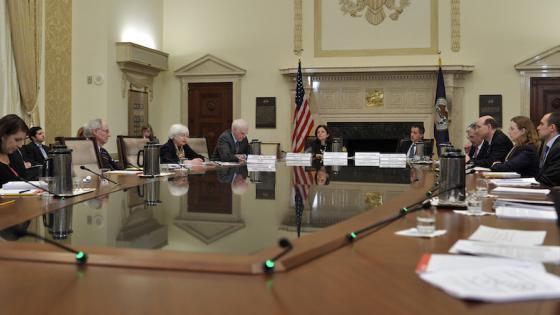Central banks make monetary policy decisions in response to economic conditions. These responses are called systematic monetary policy, or the ‘policy rule’. In theory, systematic monetary policy shapes the transmission of macroeconomic shocks, such as fluctuations in oil prices, technological changes, or shifts in fiscal policy. Yet, gauging these causal effects in the data without imposing strong assumptions is challenging. In the words of Bernanke et al. (1997), “[u]sing time-series evidence to uncover the effects of monetary policy rules on the economy is a daunting task.”
In a recent paper (Hack et al. 2023), we tackle this challenge. Our measure of systematic monetary policy reflects the historical composition of hawks and doves in the Federal Reserve's Federal Open Market Committee (FOMC) since 1960. The classification of FOMC members as hawks or doves is based on narratives from news archives, portraying them as either more concerned about inflation (hawks) or more concerned about supporting employment and growth (doves), as in Istrefi (2019).
To address concerns that economic conditions or political developments may influence the balance of hawks and doves in the FOMC, we exploit the rotation of voting rights in the FOMC.
Specifically, we exploit the fact that four out of 12 voting rights in the FOMC are mechanically rotated each year among 11 Presidents of the Federal Reserve Banks.
This introduces exogenous variation in the FOMC’s hawk-dove balance, enabling us to identify the causal effects of systematic monetary policy in the US. The idea is that when FOMC members rotate in and out, the mix of hawks and doves in the FOMC is affected for reasons unrelated to the macroeconomy.
As shown in Figure 1, both the overall hawk-dove balance and the FOMC rotation instrument display large fluctuations over time, mainly reflecting the turnover of members and the rotation of voting rights. While the Federal Reserve's response to macroeconomic shocks is highly sophisticated and depends on various economic factors, we argue that our hawk-dove balance corresponds well to narratives of monetary policy in the US (Istrefi 2019, Hack et al. 2023).
Figure 1 Historical variation in the Federal Reserve’s systematic monetary policy represented by the FOMC hawk-dove balance
Source: Hack et al. (2023).
Notes: The solid red line shows the quarterly time series of the aggregate Hawk-Dove balance of the FOMC from Q1 1960 until Q1 2023. The balance is an aggregate of individual policy preferences of FOMC members in period t, where +1 means all FOMC members are hawks and -1 means all FOMC members are doves. The dashed red line shows the aggregate hawk-dove balance of the subgroup of rotating Presidents of Federal Reserve Banks with voting rights in period t. Grey bars indicate recessions as identified by the National Bureau of Economic Research (NBER).
Fiscal spending shocks and the response of different monetary policy flocks
How monetary policy reacts to fiscal policy is considered crucial for the effects of fiscal policy, not only in policy debates (e.g. Blinder 2022) but also in economic theory (e.g. Woodford 2011, Farhi and Werning 2016). Recent expansions in government spending during the COVID-19 pandemic (Baldwin and Weder di Mauro 2020), the war in Ukraine (Trebesch et al. 2023, Chebanova et al. 2023) or the recent inflation surge (Dao et al. 2023) make this question highly relevant for current policymaking. Despite the importance of the debate, we lack direct causal evidence on how systematic monetary policy shapes the effects of government spending shocks.
We assess the effects of US government spending shocks on the economy accounting for the hawkishness of the FOMC. In our regression model, macroeconomic variables such as real GDP, government spending, the federal funds rate or inflation expectations may respond to the spending shock and the interaction between the spending shock and the hawk-dove balance in the FOMC. To identify the causal effects of the hawk-dove balance, we use our FOMC rotation instrument. Our spending shocks are discretionary changes in military spending due to unforeseen military build-ups (or ‘build downs’) between 1960 and 2014, taken from Ramey (2011) and Ramey and Zubairy (2018).
Figure 2 compares the estimated effects of an expansionary government spending shock under a hawkish and a dovish FOMC. The impact of this shock on real GDP is highly dependent on the hawkishness of the FOMC.
When the FOMC is more dovish (+2 doves relative to the average FOMC), higher government spending leads to a significant GDP expansion. Conversely, when the FOMC is more hawkish (+2 hawks), increased spending does not lead to a GDP expansion but rather a decline in GDP.
Figure 2 Comparing the effects of an expansionary government spending shock under a hawkish and a dovish FOMC
Source: Hack et al. (2023).
Notes: The chart shows the responses of real GDP, the federal funds rate and inflation expectations to an expansionary military spending shock, corresponding to 1% of GDP, conditional on systematic monetary policy. The line in red (blue) captures the state-dependent responses when the hawk-dove balance exceeds the sample average by two hawks (doves). The shaded areas indicate the 68% and 95% confidence bands.
The striking differences in the GDP response align with the reaction of the policy rate. Under a hawkish FOMC, the federal funds rate increases in response to the spending shock, effectively preventing a rise in inflation expectations. Conversely, with a more dovish FOMC, the federal funds rate initially falls, accompanied by a rise in inflation expectations. A dovish FOMC thus delays policy tightening in response to fiscal expansion.
Finally, in assessing the effectiveness of fiscal spending, a standard measure is the fiscal multiplier, indicating the dollar increase in GDP per additional dollar of government spending. With a hawkish FOMC, the multiplier is insignificant, with estimates at or below zero. In contrast, under a dovish FOMC, the multiplier is highly statistically significant, ranging between two and three.
Don’t reckon without hawks and doves
Our findings highlight the power of monetary policy to steer the macroeconomy. Consequently, the effects of fiscal policy cannot be gauged reliably without accounting for the response of monetary policy. Applied to recent years, our findings suggest that the combination of fiscal expansions of 2020 and a dovish FOMC may have played a role in the robust recovery in GDP.
Authors’ Note: This column first appeared as a Research Bulletin of the European Central Bank. The authors gratefully acknowledge the comments from Gareth Budden, Michael Ehrmann, Alexander Popov, and Zoë Sprokel. The views expressed here are those of the author and do not necessarily represent the views of the European Central Bank or the Eurosystem.
References
Abrams, B (2006), “How Richard Nixon Pressured Arthur Burns: Evidence from the Nixon Tapes,” Journal of Economic Perspectives 20: 177–188.
Baldwin, R, and B Weder di Mauro (eds.) (2020), Mitigating the COVID economic crisis: Act fast and do whatever it takes, CEPR Press.
Bernanke, B S, M Gertler and M Watson (1997), “Systematic Monetary Policy and the Effects of Oil Price Shocks,” Brookings Papers on Economic Activity 28(1): 91-157.
Blinder, A S (2022), A Monetary and Fiscal History of the United States, 1961-2021, Princeton University Press.
Chebanova, M, O Faryna and V Sheremirov (2023), “The Economic Effects of Military Support for Ukraine: Evidence from Fiscal Multipliers in Donor Countries”, VoxEU.org, 20 June.
Dao, M, A Dizioli, C Jackson, P Gourinchas and D Leigh (2023), “Unconventional Fiscal Policy in Times of High Inflation,” IMF Working Paper No. 178.
Hack, L, K Istrefi and M Meier (2023), ”Identification of Systematic Monetary Policy”, ECB Working Paper No. 2851 and CEPR Discussion Paper No. 17999.
Istrefi, K (2019), “In Fed Watchers’ Eyes: Hawks, Doves and Monetary Policy,” Banque de France Working Paper No. 725.
Farhi, E and I Werning (2016), “Fiscal Multipliers: Liquidity Traps and Currency Unions,” Handbook of Macroeconomics 2: 2417-2492.
Ramey, V A (2011), “Identifying Government Spending Shocks: It’s all in the Timing,” The Quarterly Journal of Economics 126: 1-50.
Ramey, V A and S Zubairy (2018), “Government Spending Multipliers in Good Times and in Bad: Evidence from U.S. Historical Data,” Journal of Political Economy 126: 850-901.
Trebesch, C, A Antezza, K Bushnell, A Frank, P Frank, L Franz, I Kharitonov, B Kumar, E Rebinskaya and S Schramm (2023), "The Ukraine Support Tracker: Which countries help Ukraine and how?," IfW Kiel Working Paper No. 2218.
Woodford, M (2011), “Simple Analytics of the Government Expenditure Multiplier,” American Economic Journal: Macroeconomics 3: 1-35.








